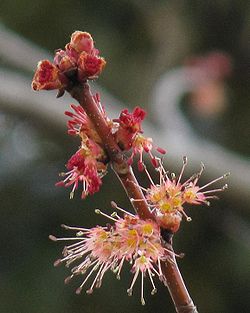en
names in breadcrumbs


Acer pycnanthum, the Japanese red maple, (ハナノキ, hananoki, or 花の木, hanakaede, meaning "flower maple") is a species of maple native to Japan, and introduced to Korea.[3] A tree usually about 20 m, reaching 30 m, it prefers to grow in relict mountain wetlands. It flowers in April, prior to the emergence of leaves.[4] Although considered Vulnerable in its native habitat, it has found some use as a street tree, and is the official tree of a number of Japanese municipalities and of Aichi Prefecture.[1]
Acer pycnanthum is dioecious, with separate male and female flowers.[5] The bark is grey and longitudinally fissured, sometimes giving a shaggy appearance.[6] The leaves, which emerge a bronze-green color in the spring, are shallowly lobed and have a whitish bloom on the underside. They turn yellow, orange, red, and purple in the autumn.[7] It is similar to the smaller Acer rubrum.[8]
A. pycanthum is suitable for USDA hardiness zone 5.[6] It prefers full sun to partial shade and is hardy in all of the UK and northern Europe.[7] Common problems include aphids and verticillium wilt.[8]
Acer pycnanthum, the Japanese red maple, (ハナノキ, hananoki, or 花の木, hanakaede, meaning "flower maple") is a species of maple native to Japan, and introduced to Korea. A tree usually about 20 m, reaching 30 m, it prefers to grow in relict mountain wetlands. It flowers in April, prior to the emergence of leaves. Although considered Vulnerable in its native habitat, it has found some use as a street tree, and is the official tree of a number of Japanese municipalities and of Aichi Prefecture.
Acer pycnanthum is dioecious, with separate male and female flowers. The bark is grey and longitudinally fissured, sometimes giving a shaggy appearance. The leaves, which emerge a bronze-green color in the spring, are shallowly lobed and have a whitish bloom on the underside. They turn yellow, orange, red, and purple in the autumn. It is similar to the smaller Acer rubrum.
A. pycanthum is suitable for USDA hardiness zone 5. It prefers full sun to partial shade and is hardy in all of the UK and northern Europe. Common problems include aphids and verticillium wilt.

Spring flowers and leaf buds
Acer pycnanthum est un arbre de la famille des Aceraceae, ou des Sapindaceae selon la classification phylogénétique. C'est un érable originaire du Japon et de Corée.
Acer pycnanthum é uma espécie de árvore do gênero Acer, pertencente à família Aceraceae.[1]
Acer pycnanthum là một loài thực vật có hoa trong họ Bồ hòn. Loài này được K.Koch mô tả khoa học đầu tiên năm 1864.[1]
Acer pycnanthum là một loài thực vật có hoa trong họ Bồ hòn. Loài này được K.Koch mô tả khoa học đầu tiên năm 1864.

Acer rubrum L. var. pycnanthum (K.Koch) Makino
和名 ハナノキ(花の木)ハナノキ(花の木、学名 Acer pycnanthum)はカエデ科カエデ属の落葉高木。カエデの仲間である。ハナカエデとも言う。カエデ科は、新しいAPG植物分類体系ではムクロジ科に含められている。
樹高は30mに達する。雌雄異株。冬芽は5-7対の鱗片が瓦重ね状に並び、濃紅色になる。
花期は4月で、葉が展開する前に赤い花を咲かせる。これが名前の由来となっている。花序は前年枝の葉腋に4-10個束状につく。雄花の花柄は長さ5-6mmになり上向き、花弁は0-5個、萼片は5個、雄蕊は5-6本あり、葯は黒紫色になる。雌花の花柄は長さ1-1.5cmになり垂れ下がり、花弁は4-5個、花柱の長さ4-4.5mm、退化雄蕊が5-6本ある。果期は6月。果柄は6-7cm。
果実は翼果で、分果の長さは2.5cmになり、翼果は直角から鋭角に開く[1][2]。
葉は対生する。葉身は長さ2.5-8cm、幅2-10cmの広卵形で、掌状の3脈があり、ふつう先が浅く3裂するが、ときに無裂のものもある。縁は重鋸歯になり、葉先は鋭くとがり、基部は浅心形から広いくさび形、裏面はふつう粉白色になる。葉柄は葉身の0.5-1.3倍ほどになり、長さ1.5-8cmになる[1][2]。秋には鮮やかに葉が紅葉または黄葉する。
日本の固有種で、長野県南部・岐阜県南部・愛知県北東部の3県県境のおもに木曽川流域の山間湿地に自生し、長野県大町市の居谷里湿原に隔離分布する[1][3]。自生地は山間の川岸や湿原などの湿地[2]。滋賀県の国の天然記念物に指定されているものは、自生地から移植されたものと考えられている[3]。最近では街路樹や公園などに植栽されていることも多い。
自生地などが国の天然記念物に指定されている他、愛知県の県木ともなっている。環境省のレッドリストでは絶滅危惧II類に選定されている。
近江国、美濃国、尾張国などではこれを栽培するものもあったが、自生種は飯沼慾斎「草木図説」、伊藤圭介「日本産物志」に、美濃、信濃国の山中にあることが記されているだけであった。久しく知られることなく、明治末年、岐阜県恵那郡坂本村(現・中津川市)に自生していることが発見され、その後県内で自生しているのを発見された。岐阜県中津川市坂下(椛の湖の北岸の湿地帯)岐阜県土岐市(白山神社 (土岐市泉中窯町))や滋賀県愛知郡湖東町(現・東近江市)南花沢のものが有名である。
絶滅危惧II類 (VU)(環境省レッドリスト)
2012年8月レッドリスト